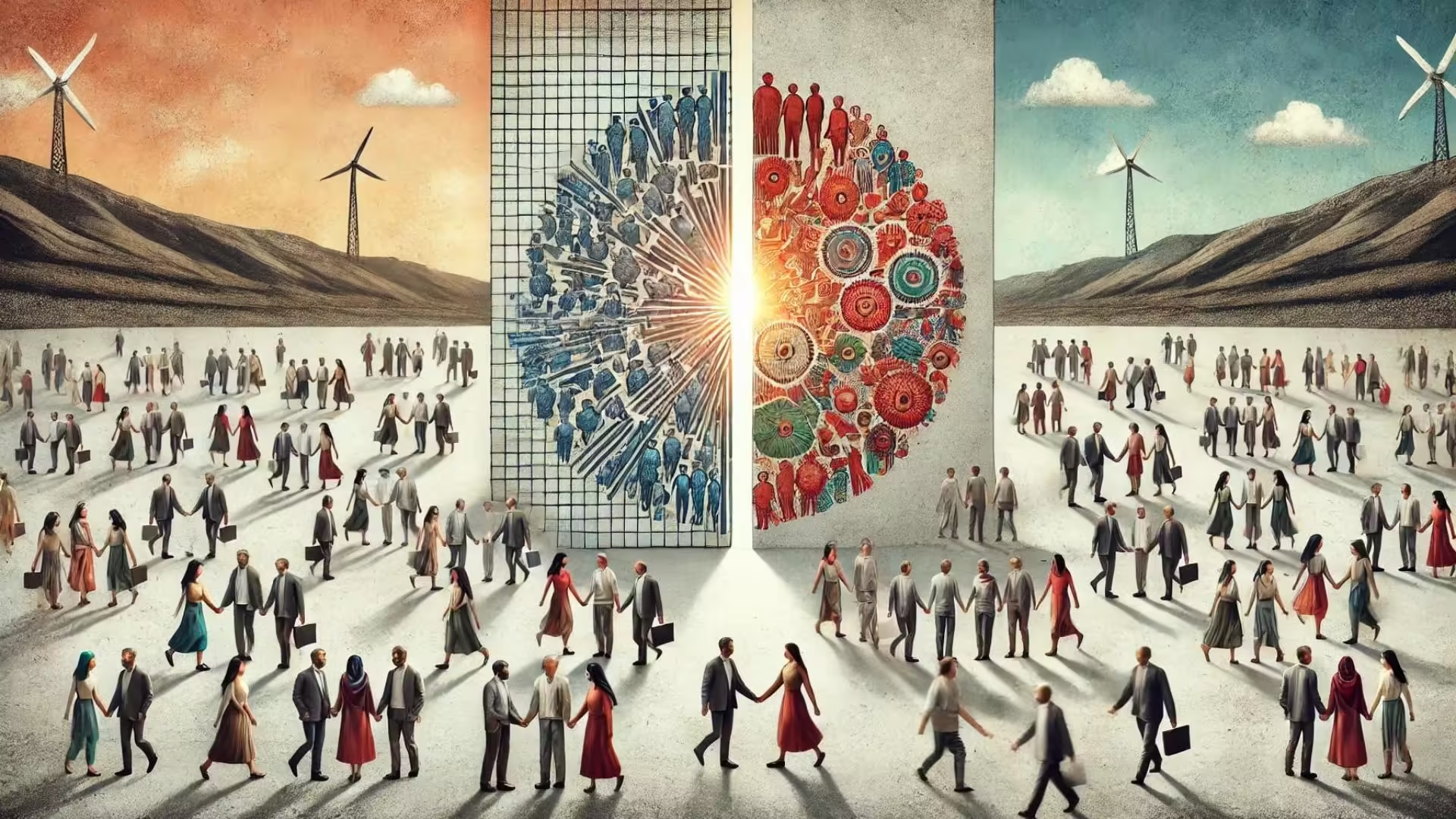- What is Cultural Assimilation?
- Real-Life Example: The Melting Pot
- What is Cultural Integration?
- Real-Life Example: The Mosaic
- Key Differences Between Cultural Assimilation and Cultural Integration
- Importance of Understanding These Concepts
- Real-Life Implications
- Taking Action: Embracing Cultural Integration
- Expand Your Vocabulary
- Let’s Talk
In today’s interconnected world, societies are becoming increasingly diverse. As people from different cultural backgrounds come together, the ways in which they interact and merge with one another’s cultures become critical to the fabric of social cohesion. Two terms often used in this context are cultural assimilation and cultural integration. Understanding the differences between these concepts is essential for fostering inclusive and harmonious communities. This article will delve into the meanings of cultural assimilation and cultural integration, explore their impacts on society, and highlight the importance of embracing cultural diversity with real-life examples.
What is Cultural Assimilation?
Cultural assimilation occurs when individuals or groups from different cultural backgrounds adopt the dominant culture’s norms, values, and practices, often losing their original cultural identity in the process. This concept implies a one-way process where the minority culture is absorbed into the majority culture, leading to a homogenized society.
Real-Life Example: The Melting Pot
The United States has long been described as a “melting pot,” where immigrants from various backgrounds are expected to assimilate into American culture. This idea suggests that, over time, different cultures blend into a single, unified culture. For instance, many immigrants in the early 20th century were encouraged to adopt English, celebrate American holidays, and embrace Western dress and customs, often at the expense of their native languages and traditions.
What is Cultural Integration?
Cultural integration, on the other hand, refers to a process where individuals or groups from different cultural backgrounds come together and coexist while maintaining their distinct cultural identities. This concept promotes mutual respect, understanding, and adaptation, leading to a multicultural society where diversity is celebrated.
Real-Life Example: The Mosaic
Canada is often referred to as a “cultural mosaic,” where various cultural groups retain their unique identities while contributing to the broader society. In cities like Toronto and Vancouver, one can find neighborhoods rich in cultural diversity, where people maintain their traditions, languages, and festivals. This integration fosters a society that values inclusivity and respects different cultural perspectives.
Key Differences Between Cultural Assimilation and Cultural Integration
Process and Outcome
- Cultural Assimilation: Involves the absorption of minority cultures into the dominant culture, leading to a loss of original cultural identities. The outcome is a more homogenous society.
- Cultural Integration: Encourages the coexistence of diverse cultures, allowing individuals to retain their unique cultural identities. The outcome is a multicultural society that values diversity.
Power Dynamics
- Cultural Assimilation: Often involves power imbalances, where the dominant culture imposes its norms and values on minority cultures.
- Cultural Integration: Seeks to balance power dynamics by promoting mutual respect and understanding among different cultural groups.
Social Impact
- Cultural Assimilation: Can lead to social tension and loss of cultural heritage, as individuals may feel pressured to conform to the dominant culture.
- Cultural Integration: Promotes social harmony and cultural preservation, as individuals are encouraged to share and celebrate their cultural differences.
Importance of Understanding These Concepts
Understanding the difference between cultural assimilation and cultural integration is crucial for fostering inclusive communities. By recognizing and valuing cultural diversity, societies can benefit from the richness of various cultural perspectives, traditions, and innovations. This awareness can lead to more effective policies and practices that support the well-being and participation of all community members.
Real-Life Implications
Education
Schools play a vital role in promoting either cultural assimilation or cultural integration. Inclusive curricula that reflect diverse cultures and histories help students appreciate different perspectives and foster an environment of mutual respect.
Example: A school that celebrates various cultural holidays and teaches students about different cultural traditions promotes cultural integration, while a school that only acknowledges the dominant culture’s holidays may encourage cultural assimilation.
Workplace
In the workplace, fostering an inclusive environment where diverse cultural backgrounds are respected and valued can lead to greater employee satisfaction and productivity.
Example: Companies that provide cultural competence training and celebrate diversity through events and policies support cultural integration. In contrast, companies that expect employees to conform to a single cultural norm may push for cultural assimilation.
Community Engagement
Community programs and policies that encourage cultural exchange and participation from all cultural groups contribute to a more cohesive society.
Example: Local governments that support cultural festivals, language classes, and intercultural dialogue initiatives promote cultural integration, while those that do not recognize or support minority cultures may foster cultural assimilation.
Taking Action: Embracing Cultural Integration
Embracing cultural integration in your community involves actively promoting and respecting cultural diversity. Here are some ways to take action:
- Educate Yourself and Others: Learn about different cultures, their traditions, and histories. Share this knowledge with others to foster understanding and appreciation.
- Support Inclusive Policies: Advocate for policies that promote cultural diversity and inclusion in schools, workplaces, and communities.
- Celebrate Diversity: Participate in cultural events and festivals. Encourage others to celebrate and share their cultural heritage.
- Promote Dialogue: Engage in conversations with people from different cultural backgrounds. Listen to their experiences and perspectives with an open mind.
- Create Inclusive Spaces: Ensure that spaces, whether physical or virtual, are welcoming to all cultural groups. This includes schools, workplaces, community centers, and online platforms.
By embracing cultural integration, we can build a society that values and celebrates diversity, leading to richer, more vibrant communities. Understanding and applying these concepts in our daily lives can help create a world where everyone feels respected and valued, regardless of their cultural background.
Cultural assimilation and cultural integration are two distinct approaches to managing cultural diversity. While assimilation seeks to merge different cultures into one, often at the cost of losing individual cultural identities, integration encourages the coexistence and celebration of diverse cultures. By understanding and promoting cultural integration, we can create inclusive societies that respect and value the richness of cultural diversity. Take action today to support cultural integration in your community, fostering a more harmonious and vibrant world for all.
Expand Your Vocabulary
Enhance your understanding of cultural assimilation and cultural integration by exploring these ten important words and expressions mentioned in the article. Understanding these terms will help you use them effectively in everyday English.
- Cultural Assimilation
- Meaning: The process by which individuals or groups from different cultural backgrounds adopt the norms, values, and practices of the dominant culture, often losing their original cultural identity.
- Context: Cultural assimilation can lead to a homogenized society where minority cultures are absorbed into the dominant culture.
- Usage: Many immigrants experience cultural assimilation when they move to a new country.
- Cultural Integration
- Meaning: The process where individuals or groups from different cultural backgrounds come together and coexist while maintaining their distinct cultural identities.
- Context: Cultural integration promotes mutual respect and the coexistence of diverse cultures.
- Usage: Policies that support cultural integration help create inclusive and harmonious communities.
- Homogenized
- Meaning: Made uniform or similar, often at the expense of diversity.
- Context: Cultural assimilation can lead to a homogenized society where unique cultural traits are lost.
- Usage: The city’s cultural landscape has become homogenized due to the dominance of a single culture.
- Cohesion
- Meaning: The action or fact of forming a united whole.
- Context: Cultural integration fosters social cohesion by promoting understanding and cooperation among different cultural groups.
- Usage: Team-building activities can enhance cohesion within a group.
- Inclusivity
- Meaning: The practice or policy of including people who might otherwise be excluded or marginalized.
- Context: Embracing cultural integration enhances inclusivity in society.
- Usage: Inclusivity in the workplace ensures that all employees feel valued and respected.
- Mutual Respect
- Meaning: A reciprocal regard for the rights, beliefs, and traditions of others.
- Context: Cultural integration encourages mutual respect among different cultural groups.
- Usage: Mutual respect is essential for building strong and healthy relationships.
- Dominant Culture
- Meaning: The cultural group that holds the most power and influence in a society.
- Context: Cultural assimilation often involves adopting the norms and values of the dominant culture.
- Usage: The dominant culture typically sets societal norms and standards.
- Minority Culture
- Meaning: Cultural groups that are smaller in number or hold less power within a larger society.
- Context: Cultural integration allows minority cultures to maintain their identities while contributing to the broader society.
- Usage: Efforts to preserve minority culture are important for maintaining cultural diversity.
- Multicultural Society
- Meaning: A society that consists of several distinct cultural or ethnic groups.
- Context: Cultural integration promotes the development of a multicultural society where diversity is celebrated.
- Usage: A multicultural society benefits from the contributions of various cultural perspectives.
- Ethnocentrism
- Meaning: Evaluating other cultures according to the standards of one’s own culture, often with a sense of superiority.
- Context: Overcoming ethnocentrism is crucial for achieving true cultural integration.
- Usage: Ethnocentrism can hinder cross-cultural understanding and cooperation.
Let’s Talk
Engage with the deeper implications of cultural assimilation and cultural integration by reflecting on these thought-provoking questions. Consider discussing them with friends and family to gain a broader perspective.
- Personal Experiences:
- Have you ever experienced cultural assimilation or integration in your own life? How did it affect your sense of identity and belonging?
- Community Impact:
- How do you think cultural integration can enhance the sense of community in your neighborhood or city?
- Educational Systems:
- What role do schools play in promoting either cultural assimilation or cultural integration? Can you share examples from your own educational experience?
- Workplace Diversity:
- How can workplaces better support cultural integration to create more inclusive environments for employees from diverse backgrounds?
- Policy and Governance:
- What kind of policies can governments implement to promote cultural integration while respecting individual cultural identities?
- Cultural Celebrations:
- How can celebrating different cultural festivals and traditions contribute to cultural integration in society?
- Challenges and Solutions:
- What are some challenges associated with cultural integration, and how can they be addressed?
- Balancing Identities:
- How can individuals balance maintaining their cultural identity while integrating into a new society?
- Ethnocentrism:
- How can we overcome ethnocentric attitudes to better appreciate and respect cultural diversity?
- Global Perspective:
- How do global events and migrations influence cultural assimilation and integration? What can we learn from international examples?
By contemplating these questions, you can deepen your understanding of cultural assimilation and cultural integration and their significance in fostering inclusive and harmonious societies. Share your thoughts and experiences in the comments below, and let’s start a meaningful conversation!










0 Comments